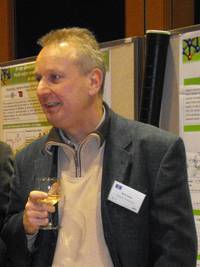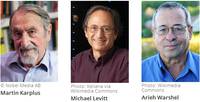Life is a nanofilm
Excerpts from Die Zeit article,
“Das Leben ist ein Nanofilm”
(Life is a nanofilm) by Paul Janositz, 09.10.2013
The Nobel Prize Awardees in Chemistry 2013 are film producers. Using their simulation techniques, biochemistry taking place in our body becomes visible.
Seeing, hearing, tasting or feeling – our body is constantly working so that we can do all that. Biochemical nanomachines, complex proteins, do this job. 24 hours a day. Lightening fast. Invisible from the outside.
While they are labouring, they are in constant motion. Each of these nanomachines does something different and each looks accordingly different: its folds and its complex structure are crucial so that each can complete its tasks properly.
But how to study this 24-hour a day job of the proteins in a human body? Looking in at the nanoscale is difficult. In any case, the actions are so unbelievably fast, that one would only be able to get a snapshot. This is exactly where the computer model, that this year’s Nobel Prize winners in Chemistry developed, comes in to play. It simulates biochemistry on an atomic level, almost in real time and extremely accurately. If the structure and chemical composition of the nanomachine is known, one can calculate rather exactly how they react chemically.
Martin Karplus, Michael Levitt, and Arieh Warshel succeeded in dramatically simplifying the methods of calculation while still obtaining exact results.
Martin Kaupp, Professor of quantum chemistry at the TU Berlin, first met Karplus, “the grand old man of theoretical chemistry” at a lecture during a study trip to the USA, and later frequently at conferences along with Levitt and Warshel. Kaupp describes Karplus as a humorous lecturer, and is happy that a theorist has finally been awarded the Nobel Prize in Chemistry again. He believes this demonstrates the growth of the role of theory, simulation and modelling in Chemistry.
The Karplus equation, developed by the Nobel Prize Winner of the same name who was born in Vienna in 1930, is a routinely used tool in nuclear magnetic resonance spectroscopy today. Kaupp believes that Karplus’ essential contribution was to introduce quantum mechanics into the calculations and to couple them with molecular mechanics. This is casually referred to as QM/MM (quantum-mechanics/molecular-mechanics), a method that Kaupp currently teaches in his course and which is considered a standard tool for the calculation of biological systems.
The starting point of QM/MM is the consideration that it is too complicated to calculate a large protein entirely with quantum chemical methods. “Too complex, too many atoms, too much computational effort, one dies the hero’s death”, Kaupp explained. The clever idea of the Nobel laureate was to calculate the active part of the biomolecule on its own. That is where the reaction occurs, and chemical connections are broken and rebuilt. “This part of the protein does not allow itself to be calculated through classical force fields”, explains the Berlin chemist. According to the classical model, molecules are composed of spherical atoms, and the connections between them are viewed as springs. As this is not very realistic, Kaupp says, quantum mechanics must be used.
However, the quantum method is too complicated to describe an entire enzyme, a DNA strand or an organic solar cell. The trick thus lies in treating maybe 100, or maximum 200, atoms from the relevant active part quantum mechanically and the rest as a classical force field with springs and spheres. It is important to link the various parts properly and to take into account any electrostatic effects or the formation of hydrogen bridges. All this requires large computational capacity.
Calculating the right algorithm for this is complex and time consuming.
In that we are much further today than in the seventies when the scientists currently being honoured by the Nobel Prize committee carried out their pioneering work. Furthermore, the theoretical chemists today also worked to improve the dynamics, for example, to include the motion of the atomic cores, Knaupp said. The TU Berlin has the necessary computational capacity -parallel computers are used - to merge the individual reaction step snapshots into small films. Yet even with today’s enormous computer systems one reaches limits. “Nature is arbitrarily complex”, says Kaupp.


